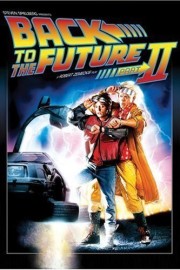Back to the Future Parts II & III
Using the iconic final lines of “Back to the Future” as a springboard, director Robert Zemeckis and screenwriter Bob Gale delve further into the paradoxes and possibilities of time travel with Marty McFly and Doc Brown. These sequels were the first of the modern era to be filmed back-to-back, and were released six months apart. Creatively, Zemeckis and Gale have some interesting ideas, but a little bit of deja vu comes into play in the execution. Yes, that’s part of the point, but especially when it comes to 1989’s “Part II,” it doesn’t work quite as well as one would hope.
The first sequel, however, has aged better than expected, no doubt because of the darker undercurrents that come out in the second act of the film, in addition to the sense of genuine imagination of the final act, in which Marty and Doc go back to 1955 to retrieve a sports almanac that changed the course of the future. The film starts with Marty, Doc, and Jennifer (now played by Elizabeth Shue) going 30 years into the future, to 2015, where Marty and Jennifer’s life isn’t quite what it should have been; apparently, Marty has a problem with people calling him chicken. But the problem right now is their kids, who are leaving a lot to be desired. Thankfully, Marty’s able to change the course of that future, but his purchase of the aforementioned sports almanac begins a chain reaction that leads to Biff Tannen (the series’s antagonist, played by the reliably tough Thomas F. Wilson) becoming a millionaire; marrying Marty’s mother, Lorraine (Lea Thompson, enjoying playing a busty, boozy, alternate reality version of the character); and murdering Marty’s father, George. This darker vision of 1985 wasn’t much fun to watch when the movie first came out, but over the years makes the film more resonate emotionally speaking, especially when Marty and Doc see the tragic fate of their lives. The fun returns in the third act, however, when Marty and the Doc must return to 1955, on the night Marty is going back to the future, to retrieve the almanac and prevent the alternate ’85 from happening, without being seen by the versions of themselves from the first film.
Sound complicated? I’ve seen trickier films over the years. Zemeckis and Gale lay out the rules succinctly and successfully, and fret not sci-fi fans, they don’t really mess with previously-established parameters of time travel from the first film, or other films. The effects may lack the polish of modern movies, but the ability to see the seams is part of the charm of watching movies from older eras, and rewatching these movies is a delight to see not just how much Zemeckis pushed the envelope even then, but how far effects have come since. And Alan Silvestri’s music continues to provide a rousing and poignant emotional experience, especially when the Doc finds himself talking to his 1955 counterpart as he is preparing to send Marty back to the future. Unfortunately, before all is said and done, Marty must go further into the past in order to help his great friend, bringing us to “Back to the Future Part III.”
After the dark events of “Part II,” it’s no wonder that audiences flocked to the western-set “Part III” in the summer of 1990. The fun and adventure of the original film returned, and the emotional journeys of the characters were more lighthearted and engaging. On the emotional front, the focus returned to the fates of the characters rather than the storytelling gimmicks of “Part II.” The main thrust of the final film in the trilogy is the fate of Doc Brown, and the most engaging part of the film is his romance with Mary Steenburgen’s Clara, a teacher with whom he shares a love of science and the unknown. Even more so than the first two films in the series, this is Christopher Lloyd’s finest couple of hours onscreen, as we see Doc less as an eccentric scientist, and more as a traditional adventure hero, such as those in the stories of Doc’s hero, Jules Verne. Lloyd and Steenburgen have wonderful chemistry together, and at the end, when Doc and Marty are trying to get back to 1985, and Clara makes an attempt to get back with Doc, well, if the emotions aren’t welling up at the exciting conclusion as a runaway train heads towards a canyon, I can’t really help you.
Still, the trilogy rises and falls on the irrepressible friendship between Lloyd’s Doc and Michael J. Fox’s Marty. These two were unlikely friends at the start of the first film, but by the midway point of the second film we understand what it is that makes these two tick as individuals, and why they have such an easy rapport as a pair. It’s arguably one of the great mentor-student pairings in film history, and the duo makes the “Back to the Future” trilogy one of the great, entertaining franchises of all-time.










